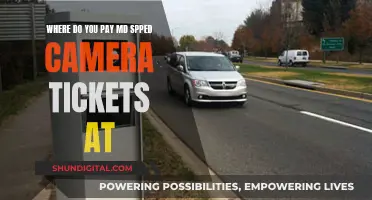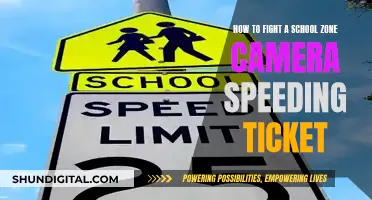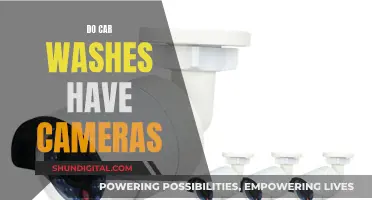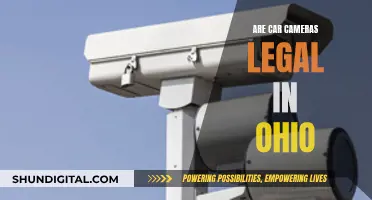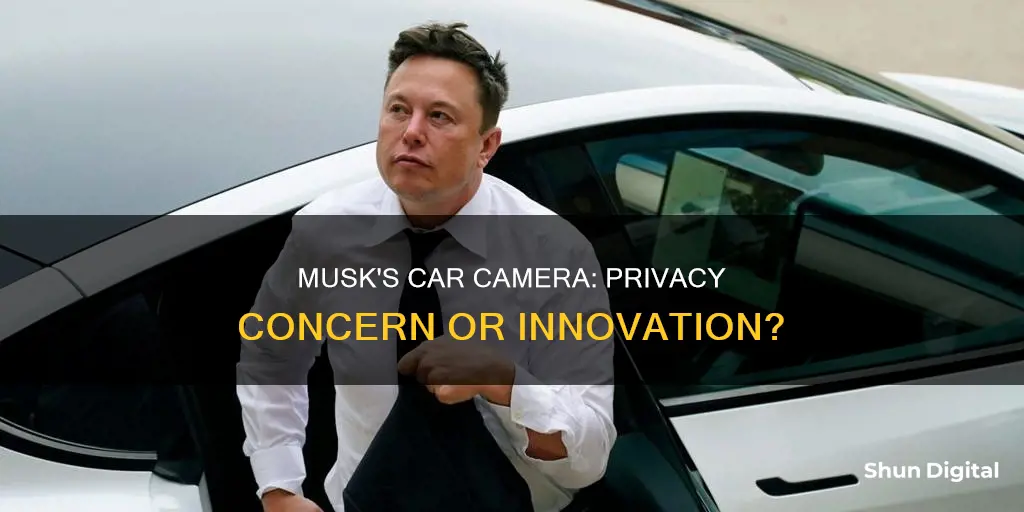
Tesla cars have been the subject of scrutiny and speculation regarding their in-vehicle cameras. While Tesla CEO Elon Musk initially stated that the cameras were meant for vandalism monitoring in a future robotaxi setting, it was later revealed that they also track driver behaviour and attentiveness. This has raised concerns about privacy and data sharing, with former Tesla employees sharing sensitive customer videos and images. The cameras are now known to be active in some models, ensuring drivers pay attention to the road when using the Autopilot feature.
| Characteristics | Values |
|---|---|
| Camera location | Above the rear-view mirror |
| Camera purpose | Monitoring driver behaviour, monitoring occupant behaviour, monitoring vandalism, and monitoring for safety |
| Camera status | Not always on |
| Camera data | Does not leave the car unless data sharing is enabled |
What You'll Learn
- The camera monitors driver behaviour
- It ensures motorists pay attention to the road
- It will be used to monitor passengers when the car works as an autonomous taxi
- Tesla employees have shared in-vehicle camera recordings without customer consent
- The camera will be used to monitor occupant behaviour in the absence of a driver

The camera monitors driver behaviour
Tesla cars have a camera installed above the rear-view mirror that monitors driver behaviour. This camera is designed to ensure motorists are paying attention to the road ahead and can address safety concerns regarding the "autopilot" driver assistance feature. The camera was initially said by Elon Musk to be inactive and meant for vandalism monitoring in a future "robotaxi" setting. However, it was later revealed that the camera was active and tracking driver attentiveness.
The camera-based driver monitoring system was implemented in Tesla's Model 3 and Model Y vehicles after the company modified these models to exclude radar sensors. This change came amid regulatory scrutiny and investigations into Tesla-involved crashes by government auto safety authorities.
The camera update in the Model 3 and Model Y vehicles detects and alerts drivers of inattentiveness while the autopilot feature is engaged. Tesla has assured customers that camera data does not leave the car and is not saved or transmitted unless data sharing is enabled.
While some customers have expressed concerns about being spied on, Tesla maintains that the camera is designed to protect the privacy of its users. The company also plans to include an option to disable the internal camera when the car is functioning as an autonomous taxi.
Other car manufacturers, such as Ford and General Motors, are also implementing similar driver-facing cameras to ensure drivers are watching the road when using semi-autonomous features.
Charging the DJI Osmo Action Camera: A Quick Guide
You may want to see also

It ensures motorists pay attention to the road
Tesla cars have a camera system that plays a pivotal role in enhancing vehicle safety. The camera, located above the rear-view mirror, monitors driver behaviour and ensures motorists pay attention to the road. This addresses safety concerns regarding the "autopilot" driver assistance feature, which has been linked to the deaths of customers. The camera system ensures that drivers keep their eyes on the road, reducing the risk of accidents and improving overall safety.
The camera system in Tesla cars has evolved significantly over the years. Initially, Tesla integrated cameras into their vehicles post-2014, using technology from MobileEye, a leader in Advanced Driver Assistance Systems (ADAS). However, with the introduction of the Model 3, Model Y, and the redesigned Model S and Model X, these models now feature nine cameras. More recent models are equipped with Hardware 4.0 (HW4), which includes eight higher-resolution cameras and two front-facing cameras.
The front cameras consist of a typical lens, a wide-angle lens, and a telephoto lens. The telephoto camera has a range of up to 250 meters, making it ideal for high-speed Autopilot use, while the main lens covers 150 meters. The wide-angle lens provides a panoramic view for navigation at complex intersections and tight curves.
The rearview camera assists with parking, reverse driving, and automatic emergency braking, providing a view of up to 50 meters behind the vehicle. Additionally, Tesla vehicles contain cameras on the fenders that monitor the vehicle's blind spots and side cameras that aid with intersections and parking.
The cabin camera, located above the rearview mirror, is a crucial component of the camera system. It monitors driver attentiveness, especially when Autopilot is engaged. This feature ensures that drivers remain focused on the road and do not become distracted or disengaged while the vehicle is in motion. The camera system also includes cameras mounted on the windshield, door pillars, and front fenders, providing a comprehensive view of the surrounding area.
While the camera system raises privacy concerns, Tesla has emphasised that data privacy is of utmost importance. The company states that camera recordings remain anonymous and are not linked to the vehicle owner or their vehicle. However, there have been instances where Tesla employees shared sensitive images and videos captured by customer cars, sparking debates about ethical boundaries and data protection.
Zosi Brand Cameras: Where Are They Manufactured?
You may want to see also

It will be used to monitor passengers when the car works as an autonomous taxi
Tesla CEO Elon Musk has confirmed that the camera above the Model 3's rear-view mirror will be used to monitor passengers when the car works as an autonomous taxi. This feature will be enabled when Tesla cars form an autonomous ride-sharing fleet, allowing Tesla owners to make extra money by renting out their cars as robotaxis.
The in-car camera will address safety concerns by monitoring driver and passenger behaviour. This will ensure motorists pay attention to the road and help prevent incidents of vandalism. Musk has stated that the camera will only be activated when the car is operating as a robotaxi and will include an option to disable it.
While some have criticised the camera as an invasion of privacy, Musk has emphasised its importance for monitoring the vehicle's interior when it is being used by others. Tesla has also stated that camera recordings remain anonymous and are not linked to specific vehicles or customers.
The development of autonomous taxi services is a key part of Musk's vision for Tesla's future, combining artificial intelligence and robotics to create a unique ride-sharing experience.
Displaying Camera Raw Data in Adobe Bridge: A Step-by-Step Guide
You may want to see also

Tesla employees have shared in-vehicle camera recordings without customer consent
Tesla's in-car cameras have been a source of controversy, with the company assuring customers that their privacy is a top priority. However, recent revelations by former employees suggest that Tesla workers have shared sensitive images and videos recorded by these cameras without customer consent. This breach of trust has raised serious concerns about privacy and ethical boundaries.
Between 2019 and 2022, groups of Tesla employees shared invasive media recorded by customer car cameras via an internal messaging system, according to interviews with nine former workers. These recordings captured Tesla customers in compromising and embarrassing situations, such as a man approaching a vehicle naked. More disturbingly, crash footage was also shared, including a video from 2021 of a Tesla hitting a child riding a bike in a residential area. The incident was spread within the company "like wildfire," according to an ex-employee.
The issue of employee access to and sharing of customer data is not unique to Tesla. Other companies, such as Amazon, Google, and Apple, have faced similar controversies with employees accessing and sharing user data without consent. This highlights the broader issue of data privacy and the potential for abuse when companies have access to extensive customer information.
While Tesla has stated that camera recordings remain anonymous and are not linked to specific vehicles or customers, former employees dispute this claim. They assert that the computer program they used at work could reveal the location of recordings, potentially exposing sensitive information about Tesla owners. This discrepancy between the company's statements and the experiences of its workers has led to concerns about the true extent of customer privacy within Tesla.
In addition to the ethical implications, the legal ramifications of this data sharing are also being considered. David Choffnes, a professor and executive director at the Cybersecurity and Privacy Institute at Northeastern University, called the actions of Tesla employees "morally reprehensible" and suggested that they may violate the company's privacy policy. German data privacy lawyer Carlo Piltz also weighed in, stating that justifying the internal sharing of videos and images under Europe's data protection laws would be challenging.
The revelation that Tesla employees have shared in-vehicle camera recordings without customer consent has significant implications for trust in the company and the broader issue of data privacy. As technology advances and companies collect more data, ensuring the protection of customer information becomes increasingly crucial. This incident serves as a stark reminder of the potential consequences of data sharing and the need for stringent privacy measures.
Chevy Cars: Onboard Cameras and Privacy Concerns
You may want to see also

The camera will be used to monitor occupant behaviour in the absence of a driver
The Tesla Model 3 and Model Y vehicles have a camera above the rear-view mirror. This camera is intended to monitor occupant behaviour in the absence of a driver. Elon Musk, the CEO of Tesla, has stated that the camera is meant for "vandalism monitoring in a robotaxi future". The idea is that once Tesla cars are able to function as fully autonomous ride-hailing vehicles, the camera will be used to identify vandals so that owners do not have to absorb the cost of any damage.
In April 2020, Musk clarified on Twitter that the camera is not currently turned on and that the car's transparent windows limit its spying value. However, he also said that the camera could be used to supplement the cameras on the outside of the vehicle as it can see through the second side windows and the rear window. This feature could enhance Tesla's Sentry Mode, which is designed to record any suspicious activity when the car is parked and alert the owner.
In May 2021, Tesla started using cabin cameras in some Model 3 and Model Y vehicles to ensure drivers are paying attention to the road when using Autopilot, the company's driver assistance system. This development came in response to safety concerns after the deaths of customers who may have relied too heavily on the "autopilot" feature. Tesla has emphasised that camera data does not leave the car itself and that the system cannot save or transmit information unless data sharing is enabled.
The use of cameras to monitor occupant behaviour in the absence of a driver is part of Tesla's plan to eventually allow owners to add their vehicles to the "Tesla Network", a ride-hailing app similar to Uber. This functionality would enable owners to profit from their cars when they are not using them. While the camera is currently inactive, it is designed to address safety and security concerns associated with autonomous vehicles.
Point-and-Shoot Cameras: Do They All Have Macro Mode?
You may want to see also
Frequently asked questions
Yes, Musk's car has a camera installed.
The camera in Musk's car, a Tesla Model 3, is meant for monitoring the driver's behaviour and ensuring they pay attention to the road. It is also intended for vandalism monitoring when the car is used as a self-driving 'Robotaxi' in the future.
Musk addressed the camera in his car in April 2020, stating that it was "not turned on" and meant for vandalism monitoring.
Some customers expressed concerns about privacy and being spied on. There were also strong reactions on Twitter, with one customer planning to trade in their car.
Yes, other car companies such as Subaru, Ford, and General Motors also use driver-facing cameras to ensure drivers pay attention to the road when using semi-autonomous features.



